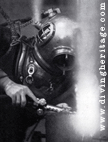SALVAGE:
In-Water INSPECTION:
- REASONS for Inspection
- Survey Inspection EQUIPMENT
- VESSEL In-Water Surveys
- Marine INFRASTRUCTURE Surveys
- MOORING Survey Inspection
- General Survey Inspections
- CORROSION Inspection
- Measuring Metal Thickness
- R.O.V. Inspection
In-Water CLEANING:
- WHY Cleaning? HOW to clean?
- HULL and RUDDER
- PROPELLER (cleaning/polishing)
- Marine INFRASTRUCTURE
- Sacrificial ANODES
- Water JETTING (high and low pressure)
In-Water REPAIRS, MAINTENANCE:
- Shipwork
- Cofferdam
- Marine INFRASTRUCTURE (overview)
- Single Point Mooring System (CALM & SALM)
- Wet WELDING & CUTTING
CIVIL WORKS & ENGINEERING:
- Dredging & Excavation off small BARGE
- Dredging, Jetting, Air-Lift, Dewatering by DIVERS
- Underwater DRILLING & BREAKING
- POST, PIPE, HOLLOW Section PILING with Portable hydraulic Hammer
- Maritime CONSTRUCTION
- Maritime DEMOLITION
- Marine OUTFALLS & Diffusers
- PIPELINES installation & maintenance
- Engineering
SEABED & EARTH ANCHORING:
- Cyclone Anchor Lines for rental

- MOORING Line: what's the (best) choice?
- HELICAL / SCREW Anchors information
- SCREW Anchors Mooring Systems
- PIPELING Anchoring
- Jetty & Walkway FOUNDATIONS screwing
- Expending Rock Anchors
- Grouted Rock Anchors
- Instant Foundation Anchors
- Earth Retention
![]()
![]()
Williams Form Engineering Corporation
- TOWAGE, Dive Support Vessel, Barges:
~ ~ ~ ~ ~ ~ ~ ~
Subsidiaries:
~ ~ ~ ~ ~ ~ ~ ~
Other useful Websites:
Diving
- ADAS Training Courses/job/careers
- New Zealand School of Commercial Diving Training
- Commercial Diving New Caledonia
Nautical Institutions
- IMCA International Marine Contractors Association
- BIMCO Baltic & International Maritime Council
- IMO International Maritime Organization
- Institute of Chartered Shipbrokers
- Institute of Marine Engineering Science and Technology
- International Federation of Shipmasters’ Associations
- International Ship Managers’ Association
- Maritime and Coastguard Agency
- Nautical Institute
- Lloyd’s List
Maritime Information

ABC Diving® Ltd
Port Vila, P.O. Box 3242 VANUATU South PacificComplete Diving Services to Vessels & Civil Engineering Industry
Please, contact us for:
HELICAL ANCHORS (or Helix Anchors, or Screw Anchors)
MOORING SYSTEMS with SCREW ANCHORS



Mooring systems for municipal and private harbors, or used in the fast growing aqua-culture field, are a cost effective way to safely secure any floating vessel.
MOORING SCREW ANCHORS
Screw Anchors offer a SIMPLE, ECONOMICAL and probably the more EFFECTIVE mooring system on the market.
SIMPLE TO INSTALL
The SCREW Anchor is installed into the harbor bottom by means of a hydraulic head driver with anti-torque devices off our work boat or small barge .
The Guy Adapter with pulling eye is installed and the Seaflex Strap or/and rope lines are connected to the mooring or platforms above.
ENVIRONMENTALLY FRIENDLY
Because these anchors do not drag around the harbour bottoms and can be effective with shorter scopes, they are preferred in environmentally sensitive areas.
These mooring systems are so EFFECTIVE, that in areas subject to hurricanes special incentives are often offered by insurance companies to boat owners who use these moorings.
BoatUS Insurance and Cruising World Magazine have conducted pull tests to compare the holding power of the typical anchors used to moor boats. Their findings have proven that helix anchors have 4 to 5 times the holding power when compared to all other alternatives.
A single helix anchor, properly installed, can withstand the pulling force of an 800 hp Tug boat. Many different test pulls, with strain gauges in the line, have registered in excess of 20,000 lbs of holding power.


Concrete Block or Helix Anchors?
"In ................., we came up with the idea of using the helical anchors for boat moorings.
They had major advantages over the older, less secure methods. They had much higher capacity, and you could shorten the scope of the rope tethering the boat to the anchor and add more boats to the harbor. Of course, with any new product, everyone wants to see the proof.
We installed an anchor off of the back of a 25-foot boat with a hand held installing unit. So there we are, two of us hanging off of the back of a boat with no good way to provide resistance to the rotation pressure.
The boat started to swing and move away from the anchor causing one helper to get stranded holding on to the anchor. The installing motor was still going and the guy got wrapped under the chain, pinned to the anchor shaft! Thankfully, no one was hurt. We eventually got the worker free and had a big laugh.
We had lined up a barge with a winch to come out and attempt to pull the anchor out as a demonstration for the harbor master.
When the barge arrived it was easy to tell that the barge operator did not think much of our “puny” helical anchor. He attached his winch line to our anchor and pulled until the barge started to pull down into the water.
The barge operator was not happy! He pulled further until the back end of the barge was up on a 45 degree angle – about to capsize. He was determined to pull it out, but the Chance helical anchor never moved.
The harbor master was convinced and we got the order to install our anchors!"
SOLID ROCK OR CORAL?
Not a problem!
So, when we encounter these substrates, we drill a hole with an underwater hydraulic sinker drill and we use EXPANDING ROCK ANCHORS.
This method can achieve optimum loading.

We can also drive MANTARAY Anchors is such sea bed.
You could be interested with:
What choice for the MOORING LINE?
°°°°°°°°°°°°°



